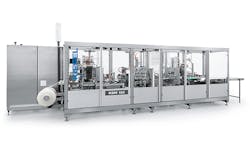Download this article in .PDF format This file type includes high-resolution graphics and schematics when applicable.
When manufacturing bags for medical fluids, extreme precision and high production speeds are of the utmost importance. The systems produced by Kiefel GmbH, Freilassing Germany, meet both requirements: The company specializes in developing and building systems for thermoforming and joining polymer films. Its machines for manufacturing infusion bags based on the contact welding method produce up to 6,500 bags per hour, while systems for making blood bags based on the high-frequency welding method produce up to 2,500 units.
Pneumatic components from Festo can be found in all Kiefel machines. The compact VFOF-LE-BAH valves offer one-way flow control, reducing assembly time and installation space requirements while making maintenance easier.
Pneumatics Right Down the Line
The new one-way flow control valves not only control the piston speed of cylinders, but also allow for an intermediate stop in a predefined position. Parts can be held and processed in this position, and lowering in the event of the compressed air being disconnected briefly can be prevented. To reduce potential risks as per the Machinery Directive 2006/42/EC, a manual exhaust function is used which switches the drive to the energy-free state if the compressed air supply has been disconnected.
This high-production machine relies heavily on pneumatics technology for fast and precise manufacturing of 6,500 infusion bags per hour.
Along with VFOF-LE-BAH, several other Festo components ensure efficient pneumatic processes in Kiefel systems. These include service units for compressed air preparation, valve terminals, and individual valves and cylinders. The latter are used, for example, to move the grippers for feeding the film and to operate punching, embossing, printing, and welding equipment.
From Film to Bag
Although the individual systems from Kiefel are all used to produce different products, the fundamental automation principle behind the medical technology machines is the same. The process is best illustrated by a new system for manufacturing infusion bags. In the first step, the film is unrolled. Dancer rollers perform a buffer function to cushion the synchronized motion sequences. They isolate the power from the machine, which is needed to set the parent roller in motion.
This is followed by contactless electrostatic cleaning of the film and application of the product-specific information in the printing station. The system laterally feeds a film with the print medium. The inlet and outlet tubes for fluids such as blood or infusion solutions are then welded on. In the next processing step the entire bag is welded and the cooling systems then reduce the temperature of the welded sections. Finally, the bags are separated by punching or cutting, placed on a conveyor, and transported onwards.
Festoâs VFOF-LE-BAH offers three advantages over conventional one-way flow-control valves: small size, easy installation, and on-cylinder mounting.
Three Functions, One Valve
Until a year ago, two pneumatic control elements—Festo’s GRLA one-way flow control valve and HGL shut-off valve—were still required on many cylinders. The GRLA was used to adjust the flow rate, while the HGL blocked the flow in one direction. The blocked connection could be opened again by a control signal. Both valves are still installed in systems where called for by the design specifications.
In other areas, however, the VFOF-LE-BAH valves offer the advantage of integrating three functions: variable piston speed, short intermediate stop, and individual manual exhaust. The efficient control element therefore saves time and money and reduces the installation space by more than 5%. (For more on space-saving techniques, see “Avoiding the Crowd.”) It is easy to operate and assemble and can be used everywhere. The pneumatic control elements offer versatile functionality, are energy-efficient and non-polluting, and reduce compressed air losses.
The VFOF-LE-BAH offers easy adjustment of cylinder speed, in large part because of its on-cylinder mounting.
Two-thirds Less Assembly Time
For Peter Kronawitter, Pneumatics Design Engineer at Kiefel, specifying the VFOF-LE-BAH valves has paid off right down the line. “Previously, our installation technicians had to install up to three different parts,” he explains “Now they install just one pneumatic component. Assembly now only takes a third of the time that it used to.”
Kronawitter also sees benefits for his company in the extensive portfolio of Festo pneumatic products, as well as in the fast, worldwide spare parts delivery service. “This has permanently reduced our warehousing requirements,” he says. With the one-way flow control valve VFOF-LE-BAH, Festo has opened up new possibilities in terms of time and space savings for Kiefel.














